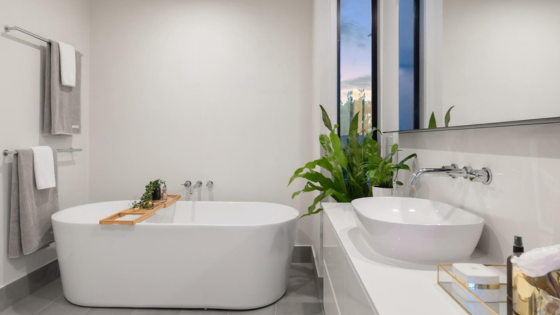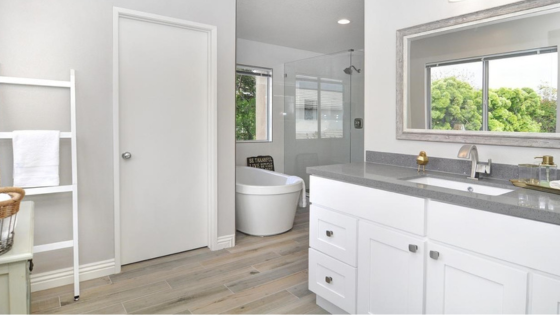Embarking on a bathroom renovation journey is an exciting venture that blends creativity with practicality. This process is evident in places like Arlington Heights, Illinois, where homes reflect a harmonious blend of traditional charm and contemporary living. In this vibrant community, known for its picturesque neighborhoods and a keen sense of local pride, homeowners are increasingly looking to infuse their personal style and modern conveniences into their bathroom spaces.
Renovating a bathroom in Arlington Heights, or any similar locale, isn’t just about updating fixtures or adding a fresh coat of paint; it’s about creating a space that resonates with the evolving lifestyles of its residents. It’s about designing a retreat that not only complements the architectural integrity of the area’s homes but also meets the modern-day demands for functionality and efficiency. As a result, homeowners in Arlington Heights are often meticulous in their planning, seeking to balance the area’s suburban appeal with the latest trends and innovations in bathroom design.
This article aims to guide you through the key considerations and effective strategies for a successful bathroom renovation, offering tips that cater to both the aesthetic aspirations and practical needs of homeowners. Whether you’re in Arlington Heights or beyond, these insights will help you navigate your bathroom remodeling project with confidence and clarity.
10 Bathroom Renovation Tips You Need To Know
 1. Choosing the Right Contractor
1. Choosing the Right Contractor
The first step in a successful bathroom renovation is finding the right contractor, one who blends expertise with local knowledge. This is particularly important if you’re looking for bath remodelers in Arlington Heights, as they will have a deep understanding of the specific requirements and trends in the area.
When selecting a contractor, consider the reputation and expertise of local firms, such as Matrix Home Solutions, known for their quality work in the region. Ensure that they are licensed and insured, and don’t hesitate to ask for references to gauge their reliability and quality of work.
A good contractor will not only realize your vision but also contribute valuable insights and suggestions based on their extensive experience in the field.
2. Setting a Realistic Budget
A realistic budget is the backbone of any renovation project. Start by determining how much you can afford to spend and then allocate funds to different aspects of the renovation, like labor, materials, and a contingency for unexpected expenses.
Be transparent with your contractor about your budget. This will help them suggest materials and designs that align with your financial constraints. Remember, it’s better to invest in quality for long-term benefits rather than cutting corners that could lead to more costs in the future.
3. Design for Functionality and Style
Your bathroom should be a perfect blend of style and functionality. When planning the design, consider who will be using the bathroom and how. For instance, if it’s a family bathroom, you might need more storage space and a durable design. If it’s a master bath, you might focus more on luxury and relaxation. Keep in mind the latest design trends, but also think about timeless elements that won’t feel outdated quickly. Don’t forget to consider the overall style of your home for a cohesive look.
4. Choosing Durable and Quality Materials

The materials you choose for your bathroom renovation should be both aesthetically pleasing and durable. For flooring and wall tiles, consider porcelain or ceramic, as they are both durable and water-resistant. When it comes to fixtures, quality is key. Opt for materials that resist corrosion and tarnishing. Remember, the bathroom is a high-moisture environment, so selecting materials that can withstand these conditions is crucial for the longevity of your renovation.
5. Maximizing Space and Storage
Effective use of space is crucial, especially in smaller bathrooms. Plan a layout that maximizes the available space without making the bathroom feel cramped. Utilize smart storage solutions like built-in cabinets, vanity under-space, and wall-mounted shelves to keep the bathroom organized and clutter-free. Consider using large mirrors and glass shower doors to create an illusion of space. Every design decision should contribute to creating a functional yet comfortable bathroom.
6. Efficient Lighting and Ventilation
Proper lighting and ventilation are essential in any bathroom. For lighting, consider layers – ambient lighting for overall illumination, task lighting around the mirror for grooming, and accent lighting to highlight design features. LED lights are a popular choice for their energy efficiency and longevity. Ventilation is crucial to prevent mold and mildew growth. Ensure your bathroom has an effective exhaust fan, preferably with a timer, to remove moist air. Natural light is also beneficial, so consider a skylight or a window if possible.
7. Water Efficiency and Sustainability
In today’s eco-conscious world, water efficiency is a significant consideration. Opt for low-flow toilets, faucets, and showerheads to reduce water usage without sacrificing performance. These fixtures can significantly lower your water bills and conserve valuable resources. Also, consider using sustainable materials like recycled glass tiles or bamboo flooring. Eco-friendly paints with low volatile organic compounds (VOCs) can improve indoor air quality.
8. Accessibility and Safety Features
Designing your bathroom with accessibility and safety in mind ensures it’s comfortable and usable for all ages and abilities. Features like walk-in showers, grab bars, and slip-resistant flooring can make a significant difference. For elderly users or those with limited mobility, consider installing a shower seat and adjustable shower heads. Lever-handle faucets and taller toilets can also enhance accessibility.
9. Staying on Trend: Current Design Movements

Staying abreast of current design trends can give your bathroom a modern and stylish look. However, it’s essential to balance trendiness with timelessness. Trends like floating vanities, bold wallpaper, and matte fixtures are popular and can add a contemporary touch to your bathroom. When incorporating trends, consider how they might age over time and whether they align with your personal style and the rest of your home.
10. The Renovation Timeline: Planning and Patience
Understanding the typical timeline of a bathroom renovation can help set realistic expectations. A complete remodel might take several weeks to a few months, depending on the project’s complexity. Be prepared for delays, which are common due to material lead times, unexpected structural issues, or changes mid-project. Regular communication with your contractor can keep you updated on the progress and any changes in the timeline.
Final Thoughts
Renovating a bathroom is a multifaceted project that requires careful planning and consideration of various factors. From ensuring efficient lighting and ventilation for comfort and safety to choosing water-efficient fixtures for sustainability, each aspect contributes to the functionality and aesthetic appeal of the bathroom. Incorporating accessibility features makes the space usable for everyone while keeping up with design trends and adds a modern touch.
Finally, understanding and planning for the renovation timeline ensures the project progresses smoothly. By considering these factors, you can create a bathroom that not only meets your current needs but also adds lasting value to your home. Remember, a successful renovation is a balance of form, function, and personal style – a space that you will enjoy for years to come.
 About the Author
About the Author
Lana Hawkins is a stay-at-home mum by day and author by night. She is passionate about traveling, cooking and home decor.



It got me when you said that thinking about accessibility and safety would make the bathroom comfortable and usable for any age and person. I will keep that in mind when getting a bath remodeling service this year. That part of my house really needs a makeover to also improve its cleanliness, so having ideas of what I should aim when hiring professionals will help me make informed decisions.